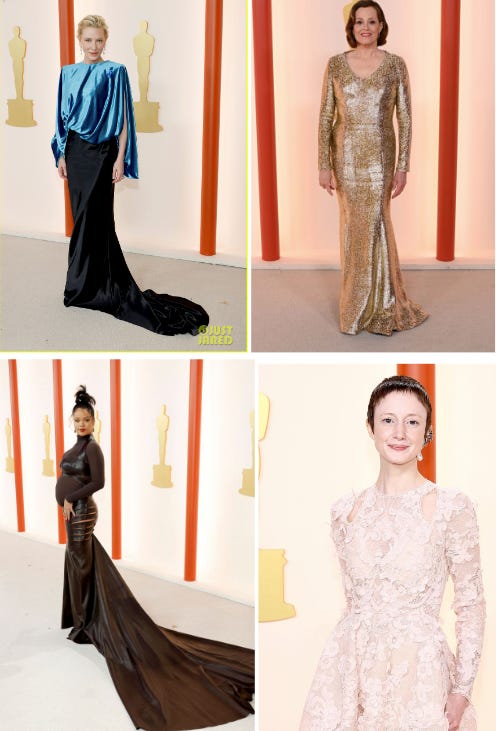Modesty
Why would God care what we wear?
I have been considering this story for a long time. I’ve been slowly gathering these interviews for about six years. Which is all to say, I’ve spent a lot of time circling this topic, and wondering how to come towards it. But here it finally is.
This is a story about modesty: mostly hijabs, but also conversations with Mormons and observants Jews about where their respective modesty dress codes come from, and what they mean. But ultimately, if there are different requirements across all faiths, why would God ever care how much skin we cover?
I would rather you hear the story than to summarize it all here. But! I will use this little newsletter alert to share some fun extra stuff.
Zahava Stadler, a who practices Modern Orthodox Judaism, was an interviewee who got super real about the challenges of her dress code (“It’s hard to look young and fun while being modest”). She told me about this little game she plays, which gives a good idea of all the thought that goes into dressing modestly. Every time there’s a big televised red carpet, she organizes all the celebrities’ outfits into three tiers.
Tier 1: I could wear this look with no modifications (i.e. has sufficient coverage for me), and it doesn’t look like it belongs in the mother-of-the-bride (MOTB) section
So for example, at the 2023 Oscars, here was Zahava’s tier 1:
Malala Yousafzai got bonus points for also having a head covering. Jamie Lee Curtis was “borderline MOTB. Saved mostly by the corset-style boning.” Other Tier 1 members were Melissa McCarthy, Catherine Martin, Sabrina Dhowre Elba, Alice Rohrwacher, Sandra Drzymalska, Tia Carrere.
As you can see. Tier 1 looks often tend to rely on sequins.
Tier 2: I could wear this look with minor modifications and it doesn’t look like it belongs in the MOTB section, or it could be worn with no modifications but is MOTB
At the 2023 Oscars, these were some of Zahava’s tier 2 selects:
See - they’re close. Cate Blanchett would have to close those cap sleeves, Sigourney Weaver would have to raise that neckline a few inches, and Rihanna and Andrea Riseborough would need to add linings to make their dresses not-see-through.
Tier 3: I could wear this look with moderate modifications and it doesn’t look like it belongs in the MOTB section, or it could be worn with minor modifications but is MOTB
Some of Zahava’s Tier 3 picks from the 2023 Oscars were Hong Chau (“add sleeves”), Nicole Kidman (“add a second sleeve and close slit”) and Jessie Buckley (“add lots of lining; though this really strains the definition of ‘moderate’”), Lady Gaga (“same”)
These are just Zahava’s personal rankings- she has a whole whatsapp thread with her friends arguing what belongs in what tier. But it just goes to show that there is a lot to consider when trying to dress modestly. Especially if you are not going to the red carpet and aren’t ordering something bespoke.
Whether you’re trying to cover yourself for religious reasons, or to stay out of the sun, or just because you want to, modesty should be more of an option for everyone. So here are some options that came recommended to me, from designers and wearers of various faiths:
A Jewish interviewee recommended the brands Udel, Apparalel, Junees, and Point
A Mormon interviewee recommended Ivy City Co.
And Muslim interviewees recommended Verona (shout out to AOI sponsor Macy’s for giving them their start), and my personal favorite, Bouguessa. I love Bouguessa. Especially this coat. Beyonce even wore one of their robes
You’ll notice that… these clothes cover very similar territories. And there were a few brands that were mentioned to me across faiths, like Zahava told me about eShakti (where you can customize dresses for the coverage you need).
It’s sort of fascinating the various ways that the mandates of different faiths overlap. It’s most obvious with swimwear. Compare Kosher brand Aqua Modesta with Muslim-designed brand Splashgear (featured in the episode)!
Anyway. This is all the fun and interesting bonus stuff. The episode really gets into the nitty gritty, so I hope you’ll give it a listen.
But I’ll leave you with this one last thing. In learning about modesty, and its many associated values and virtues, I’ve started to begin to grasp what it means when women in Gaza wear their extra-modest prayer coverups all the time, for fear that they will be killed in their sleep, or have to run outside at a moments notice.
This is not how women in Gaza normally dress. This dress has become the attire of war time. This prayer coverup is a way of wresting a tiny bit of control, and claiming your body for yourself, in the midst of pure chaos.
Ok, one more episode will come out in this triptych. And then I’m going to disappear on book leave (but I’m having too much fun making this little 3-episode project I don’t want to stop)!











While each story was interesting, it was a bit frustrating for me to listen to this episode as it mostly depicted modesty in women while never exploring why the topic of modesty tends to focus more on women (just like this episode). Or I suppose in order to explore that, the episode would also have had to talk about modesty in general, difference by culture/country, aside from only religious modesty.
I remember telling a friend I didn’t feel comfortable showing my thighs, my full arms and shoulders, or my cleavage. And her answer was “but why? You have a rocking body!”
I was like, “I know, I just don’t think it should be equally available to everyone!”